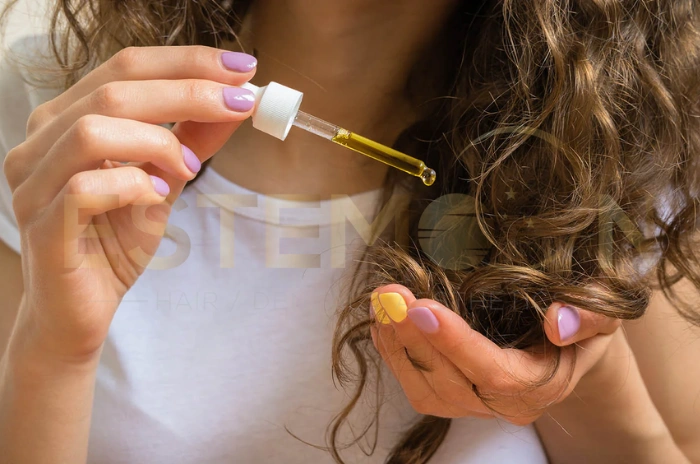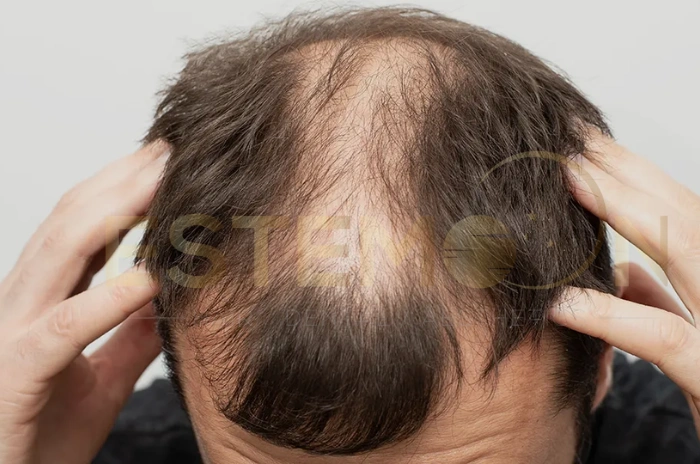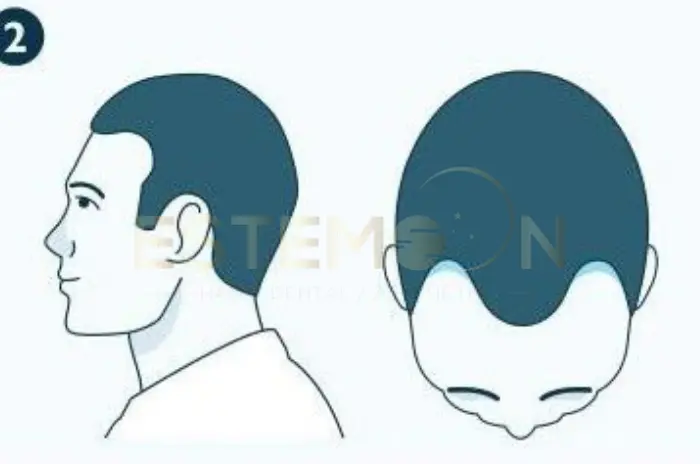Sweet almond oil for hair has become increasingly popular among beauty enthusiasts seeking natural solutions for healthier, more vibrant hair. This lightweight, nutrient-rich oil offers exceptional benefits for all hair types, from dry and damaged strands to curly and frizzy textures.
Extracted from the kernels of sweet almonds, this natural oil contains essential fatty acids, vitamin E, and proteins that nourish hair from root to tip. Unlike heavier oils that can weigh hair down, almond oil for hair absorbs easily while providing deep moisturization and protection against environmental damage.
Whether you’re dealing with hair loss, dryness, or simply want to enhance your hair’s natural shine, incorporating sweet almond oil into your routine can transform your hair care experience. This comprehensive guide will walk you through everything you need to know about using this versatile oil effectively.
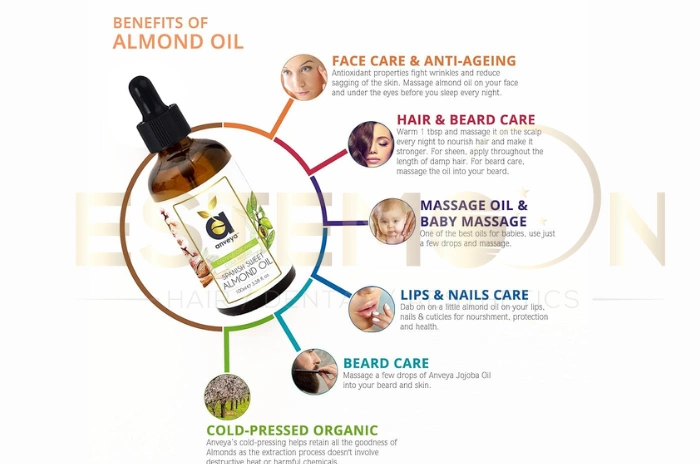
Key Benefits of Sweet Almond Oil for Your Hair
Sweet almond oil for hair delivers remarkable results thanks to its unique composition of nutrients and lightweight texture. The oil contains high levels of vitamin E, which acts as a powerful antioxidant protecting hair follicles from oxidative stress and premature aging.
The benefits of almond oil for hair extend beyond simple moisturization. Its emollient properties help smooth the hair cuticle, reducing frizz and creating a natural shine. The oil’s molecular structure allows it to penetrate the hair shaft, delivering nutrients directly where they’re needed most.
Almond oil for hair loss works by improving blood circulation to the scalp when massaged gently. This increased circulation can stimulate hair follicles and promote healthier hair growth patterns. The oil also helps strengthen existing hair strands, reducing breakage and split ends.
Regular use of almond oil for dry hair can restore moisture balance and improve overall hair texture. Unlike synthetic products that may contain harsh chemicals, sweet almond oil provides gentle nourishment without stripping natural oils or causing irritation.
Nutritional Profile for Hair Health
| Nutrient | Benefit for Hair |
|---|---|
| Vitamin E | Protects against free radical damage |
| Omega-3 Fatty Acids | Promotes scalp health and shine |
| Magnesium | Strengthens hair follicles |
| Phosphorus | Supports healthy hair growth |
| Protein | Repairs damaged hair structure |
How to Use Almond Oil in Your Hair Care Routine
How to use almond oil for hair depends on your specific hair needs and lifestyle preferences. The most basic application involves warming a small amount of oil between your palms and applying it to damp or dry hair, focusing on mid-lengths and ends.
For almond oil for frizzy hair, apply the oil to towel-dried hair before styling. Start with just a few drops to avoid weighing hair down, gradually increasing the amount as needed. The oil helps seal the hair cuticle and control humidity-related frizz throughout the day.
Sweet almond oil benefits for hair are maximized when used consistently as part of your weekly routine. Many people prefer using it as a pre-shampoo treatment, allowing the oil to penetrate for 30 minutes before washing with a gentle cleanser.
Daily Application Methods
- Leave-in treatment: Apply 2-3 drops to damp hair ends
- Styling aid: Mix with your regular styling cream
- Scalp massage: Warm oil and massage for 5-10 minutes
- Heat protectant: Apply before using styling tools
The Best Almond Oil Hair Masks for Different Hair Types
Creating an almond oil hair mask allows you to customize treatments based on your specific hair concerns. For dry, damaged hair, combine sweet almond oil with honey and egg yolk for deep conditioning and protein repair.
Almond oil for dry hair works exceptionally well when mixed with ingredients like avocado or banana. These natural combinations provide intensive moisture while the oil’s lightweight nature prevents heaviness or greasiness.
For those with oily roots but dry ends, focus the almond oil application primarily on the lower two-thirds of your hair. This targeted approach ensures proper nourishment without exacerbating scalp oiliness.
DIY Hair Mask Recipes
Moisturizing Mask for Dry Hair:
- 2 tablespoons sweet almond oil
- 1 mashed banana
- 1 tablespoon honey
- Apply for 45 minutes, then shampoo thoroughly
Protein Treatment for Damaged Hair:
- 1 tablespoon almond oil
- 1 egg yolk
- 1 teaspoon coconut oil
- Leave on for 30 minutes before washing
Why Almond Oil is Excellent for Managing Curly Hair
Almond oil for curly hair provides the perfect balance of moisture and definition without weighing down delicate curl patterns. Curly hair naturally tends to be drier due to its structure, making the nourishing properties of sweet almond oil particularly beneficial.
The oil helps define curl patterns while reducing frizz and flyaways. Unlike heavier oils that can make curls appear limp, sweet almond oil maintains volume while providing essential moisture and protection.
How to use almond oil on hair with natural texture involves applying the oil to soaking wet hair using the “praying hands” method. This technique helps distribute the oil evenly throughout curl clumps, enhancing definition and shine.
Curly Hair Application Technique
- Start with freshly washed, soaking wet hair
- Warm 1-2 teaspoons of almond oil between palms
- Apply using praying hands motion from mid-length to ends
- Scrunch gently to encourage curl formation
- Air dry or use a diffuser on low heat
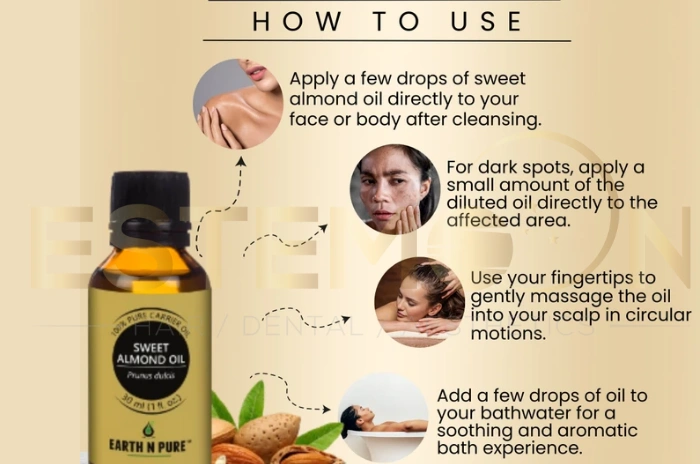
A Step-by-Step Guide to Applying Almond Oil for Hair Growth
Almond oil for hair growth requires consistent scalp massage to stimulate blood circulation and deliver nutrients to hair follicles. Begin with clean, slightly damp hair for optimal absorption and effectiveness.
Warm approximately one tablespoon of sweet almond oil in your palms before application. The gentle heat helps the oil penetrate more effectively while creating a relaxing, spa-like experience during your treatment.
How to use sweet almond oil for growth involves sectioning your hair and applying the oil directly to your scalp using your fingertips. Work in small circular motions, ensuring even coverage across your entire scalp area.
Weekly Growth Treatment Protocol
- Monday: Scalp massage with almond oil (15 minutes)
- Wednesday: Light application to hair lengths
- Friday: Deep conditioning mask with almond oil
- Sunday: Gentle scalp massage before washing
Almond Oil for a Softer and Shinier Texture
Regular use of almond oil for hair transforms texture by smoothing the hair cuticle and providing lasting moisture. The oil’s emollient properties fill in microscopic gaps in damaged hair, creating a smoother surface that reflects light beautifully.
Sweet almond oil for hair works particularly well as a finishing treatment after styling. A tiny amount applied to the palms and smoothed over styled hair adds instant shine without creating greasiness or weighing hair down.
The lightweight nature of almond oil makes it ideal for fine hair that needs moisture without heaviness. Unlike some carrier oils that can overwhelm delicate strands, almond oil provides just the right amount of nourishment and protection.
Texture-Enhancing Tips
- Use warm oil for better penetration
- Focus on damaged areas like ends and mid-lengths
- Apply to slightly damp hair for easier distribution
- Start with minimal amounts and build up as needed
How Almond Oil Compares to Other Oils Like Coconut Oil
Almond oil vs coconut oil presents an interesting comparison for hair care enthusiasts. While coconut oil penetrates the hair shaft deeply, almond oil provides surface-level protection and moisture without the risk of protein overload that some people experience with coconut oil.
Almond oil vs argan oil shows that both oils offer excellent moisturizing properties, but almond oil tends to be lighter and less expensive while still providing comparable results for most hair types.
The choice between oils often depends on individual hair needs and preferences. Sweet almond oil works well for those who want effective results without heaviness, while coconut oil might be better for severely damaged or chemically processed hair requiring deep penetration.
Oil Comparison Chart
| Oil Type | Weight | Penetration | Best For |
|---|---|---|---|
| Sweet Almond | Light | Surface-level | All hair types, daily use |
| Coconut | Medium-Heavy | Deep | Damaged, thick hair |
| Argan | Medium | Moderate | Dry, mature hair |
| Jojoba | Light | Moderate | Oily roots, dry ends |
FAQs About How to Use Sweet Almond Oil for Your Hair Routine
Can you leave almond oil in hair?
Yes, you can leave almond oil in hair as a leave-in treatment, but use only a few drops to avoid greasiness.
Is almond oil better than coconut oil?
Almond oil is lighter and better for fine hair, while coconut oil provides deeper penetration for severely damaged hair.
How often should I use almond oil?
Use sweet almond oil for hair 2-3 times per week for optimal results without over-conditioning.
What can you realistically expect from regrowth?
Almond oil moisturizes, adds shine, reduces frizz, promotes growth, and protects against environmental damage.
Follow us on social media for updates, tips, and patient success stories:

